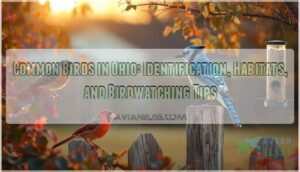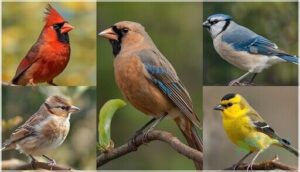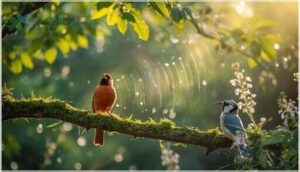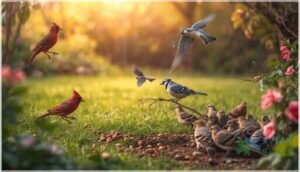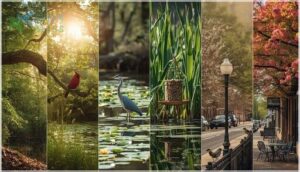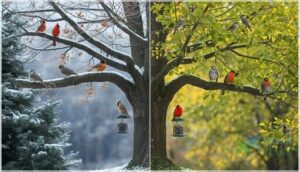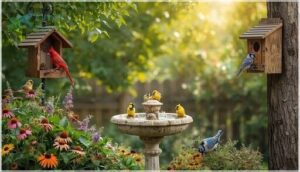This site is supported by our readers. We may earn a commission, at no cost to you, if you purchase through links.
If you’ve ever heard a robin’s cheerful song at dawn or spotted a flash of red feathers darting across your yard, you’ve already met some of Ohio’s most faithful residents. The Buckeye State hosts over 400 bird species throughout the year, but a core group of common birds in Ohio stick around no matter the season, bringing color and movement to backyards, parks, and woodlands.
These everyday visitors aren’t just pleasant to watch—they’re surprisingly easy to identify once you know what to look for. Whether you’re drawn to the bold blue jay’s raucous calls or the mourning dove’s soft cooing, learning to recognize these familiar faces opens up a whole new way to connect with the natural world right outside your window.
Table Of Contents
- Key Takeaways
- Most Common Birds in Ohio
- Identifying Ohio’s Backyard Birds
- Bird Habitats Across Ohio
- Seasonal Bird Patterns in Ohio
- Attracting and Supporting Ohio Birds
- Frequently Asked Questions (FAQs)
- What’s the most common bird in Ohio?
- How do I identify a bird in my yard?
- What is the most common backyard bird?
- What birds stay in Ohio all year?
- What birds stay in Ohio year round?
- What types of bird sounds are common in Ohio?
- How do weather changes affect Ohio bird migrations?
- Are there any endangered bird species in Ohio?
- What are the best birdwatching spots in Ohio?
- How does climate change impact Ohios bird populations?
- Conclusion
Key Takeaways
- Northern Cardinals, Blue Jays, Mourning Doves, and Downy Woodpeckers are among the most common birds seen year-round in Ohio’s backyards and woodlands.
- Seasonal migrations bring remarkable diversity, with millions of birds passing through Ohio’s forests, wetlands, and fields each spring and fall.
- You can attract and help local birds by planting native vegetation, providing clean water, and keeping a variety of feeders clean and well-placed.
- Urban expansion, habitat loss, and climate changes are shaping which bird species thrive in Ohio and highlight the importance of conservation efforts.
Most Common Birds in Ohio
If you spend any time outdoors in Ohio, you’ll spot a handful of birds more often than others. These regulars bring color and song to backyards, parks, and woodland edges alike.
Here are the most common birds you’re likely to see throughout the state.
Northern Cardinal
Few birds brighten Ohio like the Northern Cardinal. As one of the most common Ohio birds, you’ll spot these residents year-round in woodlands, gardens, and dense shrubs—classic Cardinal habitats. Their breeding behavior is easy to observe, with nests tucked in low thickets. Cardinals often raise multiple broods yearly, with the female starting a new nesting attempt soon after the first brood fledges.
Look for their vivid red feathers and listen for early morning whistles—a key for backyard bird identification.
American Robin
Spotting an American Robin in Ohio feels like seeing an old friend. Known for its warm orange breast, this backyard bird thrives in gardens and woodlands. You’ll notice its worm-hunting stroll and familiar chirp.
Robin migration sweeps flocks south come fall, while adaptable nesting habits keep them common year after year—always busy between earthworms and berries. This winter, Ohio’s robin frequencies mirrored northeastern migration patterns.
Blue Jay
Flashy and loud, the Blue Jay is impossible to miss as it sweeps through Ohio’s backyards and wooded parks. You’ll spot its blue and white feathers flashing from branch to branch.
Blue Jay habitats range far and wide, thriving in both city parks and oak-rich forests. You might even see them stash acorns, playing a secret role in oak regeneration and forest renewal.
Mourning Dove
You’ll often notice Mourning Doves perched along fences or fluttering up from gravel driveways in Ohio. Their soft gray tones, slender tails, and gentle, mournful calls set them apart in any backyard bird identification guide.
With a seed-heavy Dove Diet, adaptable Habitat Preference, and high Breeding Habits, their stable Population Trends even support regulated Dove Hunting across the state—all signs of a thriving, common Ohio bird species.
Song Sparrow
Across brushy edges and city gardens, you’ll hear the Song Sparrow’s rich vocal repertoire—each male crafts his own tune. This clever Ohio bird species thrives thanks to:
- Dietary Adaptations, shifting from insects in summer to seeds in winter
- Notable Nesting Ecology, including multiple broods per season
- Migration Patterns that swell local populations each spring and fall
A truly adaptable, common Ohio bird species.
Downy Woodpecker
Tiny beak tapping on old trees signals the Downy Woodpecker—a year-round resident of Ohio woodlands, parks, and suburbs. This common bird adjusts to developed spaces, with Population Trends holding steady.
Look for its black-and-white plumage, quick Foraging Behavior on branches, and diet of insects and seeds.
Unique Nesting Habits and flexible Habitat Needs make this Woodpecker species easy to enjoy.
House Sparrow
A quick flutter on the fence means the House Sparrow is close by. You’ll see these small birds in cities and backyards year-round, though their population has declined sharply.
Their nesting habits—inside sign letters or nestled in traffic lights—show how well they adapt to urban survival.
Loose flocks gather for seeds and scraps, but impact native birds and balance in shared habitats.
Identifying Ohio’s Backyard Birds
Spotting birds in your backyard can be both fun and a little puzzling. Each bird leaves behind clues, from the way they look to the way they move or sound. Here’s what to look for next time you’re watching those feathered visitors.
Size and Shape Clues
Spotting a bird in your yard, you might wonder—what clues does its shape give away? Relative size, weight proportions, and bill structure all matter. Some, like Northern Cardinals, show little sexual dimorphism, but Red-winged Blackbirds have bigger males.
Watch for juvenile variation too—young robins, for example, look slimmer and smaller before growing into their adult plumage and weight.
Color and Plumage Patterns
Ever wonder why some birds look so different, even within one species? Understanding plumage dimorphism, seasonal molting, and color mechanisms helps with bird identification in Ohio.
Look for these clues:
- Bold reds and masks on male cardinals (visual signaling)
- Subtle pattern recognition on song sparrows
- Seasonal molting brings brighter bird plumage
- Blue jays: color identification by structure, not pigment
Bird Songs and Calls
Think your backyard is quiet? Listen closely—bird songs and calls fill the air with Acoustic Communication you can learn to identify.
From the Northern Cardinal’s Song Complexity to the Blue Jay’s Vocal Mimicry, each Bird vocalization has a purpose.
Mastering Call Functions and Birdsong Learning brings confidence in Bird identification sounds, even when plumage blends into the branches.
Behavior and Feeding Habits
Paying attention to bird behavior and feeding habits turns quiet moments into fascinating stories right outside your window. Foraging strategies shift with the seasons and locations. You’ll notice:
- Cardinals hop low for ground seeds.
- Robins tug earthworms from lawns.
- Blue Jays carefully select nuts.
- Mourning Doves gulp seeds quickly.
- Sparrows forage together, chattering.
Bird Habitats Across Ohio
Ohio gives birds plenty of room to settle in, from forests to city blocks. Every spot offers something different, shaping which species show up and how they live.
Here’s a look at where you might find some of your favorite feathered neighbors.
Woodlands and Forests
Inside Ohio’s woodlands and forests, you’ll find some of the state’s greatest woodland bird diversity—from the scarlet tanager to the wood thrush. These habitats serve as migratory bird corridors and important breeding sites.
Yet ongoing forest bird decline and habitat fragmentation effects make conservation initiatives here essential, protecting what’s left for birdwatching and the health of bird habitats statewide.
Backyards and Suburban Areas
Backyards and suburban gardens play a big part in Ohio’s birdlife. Even a simple feeder can change which backyard birds show up, especially in winter. The layout of your yard and what you plant creates shelter and food for suburban birds.
For a better bird habitat, try these:
- Add layered shrubs and trees.
- Use bird feeders thoughtfully.
- Avoid removing natural cover.
Parks and Gardens
Let your eyes wander to Ohio’s parks and gardens, and you’ll spot urban birding in action. These green spaces bustle with common birds—from cardinals to woodpeckers—thanks to varied garden habitats and thoughtful park management.
Noise influence shapes who visits, while community gardens weave in shelter and feeding spots, connecting you to birdwatching opportunities just beyond your backyard.
Farms, Fields, and Meadows
Across Ohio’s open fields and rural areas, you’ll witness farmland bird decline firsthand. Field edge restoration and agricultural bird conservation efforts aim to reverse meadow habitat loss, but it’s a tough climb.
- Ring-necked Pheasants dropped from 5 million to just 35,000
- Eastern Meadowlarks fell over 40% since 1980
- Migratory bird stopovers depend on these farm habitats
- Vegetative strips offer vital nesting cover
Wetlands and Waterways
Throughout Ohio’s wetland habitats, you’ll find impressive bird diversity with over 74 species recorded at prime locations like Battelle Darby Creek. These marshes serve as critical migration stopovers—26 million birds crossed Ohio on September 25, 2025, alone.
Habitat restoration efforts have reclaimed 16,000 acres since 2019, supporting vulnerable species like Wood Duck and Great Blue Heron while providing essential ecological importance for birdwatching enthusiasts year-round.
Seasonal Bird Patterns in Ohio
Ohio’s bird population changes throughout the year, with some species sticking around while others come and go with the seasons. Understanding these patterns can help you know what to expect at your feeder or in the field.
Let’s look at which birds stay put, which ones migrate, and how to make the most of each season’s birdwatching opportunities.
Year-Round Resident Species
You’ll spot several species in your Ohio backyard every single month of the year. Northern Cardinals, Blue Jays, and Mourning Doves show considerable resident bird stability, with population density factors remaining steady across seasons.
These common Ohio bird species have mastered winter survival strategies through habitat adaptation. Downy Woodpeckers, Black-capped Chickadees, and White-breasted Nuthatches also stick around, making backyard birds reliable neighbors through climate change impacts.
Common Migratory Birds
Ohio hosts more than 450 bird species annually, with millions passing through during migration patterns. Swainson’s Thrush peak in September, while Blackpoll Warblers arrive in late September and early October.
Radar tracking and citizen science help monitor these common Ohio bird species through stopover habitats like forests and wetlands, supporting species conservation efforts across the state’s migration corridors.
Winter Birdwatching Tips
When temperatures drop, you can make your backyard a lifeline for Ohio birds. Winter feeding with high-fat options like suet and black oil sunflower seeds boosts survival—studies show fed chickadees survive winter at twice the rate of unfed birds.
Support your backyard birds by:
- Offering heated water access for drinking and bathing
- Cleaning feeders every two weeks to prevent disease
- Positioning feeders to reduce collision risks
Join citizen science programs like Project FeederWatch to track winter birds while you watch.
Spring and Fall Migration Highlights
Each spring and fall, Ohio transforms into a major highway for migratory birds. During the spring migration season, mid-May brings over 150 million birds through northern Ohio alone, while the fall migration season peaks in September with 26 million birds overhead in a single night. You can spot these nocturnal flights starting 30–45 minutes after sunset, when warblers, thrushes, and sparrows travel at altitudes up to 10,000 feet.
These bird migration patterns reveal fascinating altitude behavior—migrants commonly fly at speeds around 22 mph, guided by weather conditions and seasonal daylight shifts. The habitat impact of this massive movement makes Ohio’s wetlands and woodlands critical stopover points, where restoration efforts directly support the conservation of these long-distance travelers.
Ohio’s migratory birds fly at 22 mph and 10,000 feet, making the state’s wetlands and woodlands critical stopover points worth protecting
| Season | Peak Migration Timing | Notable Migratory Species |
|---|---|---|
| Spring | Mid-May (15–21) | Yellow Warblers, Palm Warblers, Golden-crowned Kinglets |
| Fall | Late September–Early October | Swainson’s Thrush, American Redstart, Blackpoll Warbler |
| Early Fall | Late July–August | Swallows (earliest migrants) |
| Late Fall | Late September–October | White-throated Sparrows, Song Sparrows |
Attracting and Supporting Ohio Birds
Turning your yard into a haven for Ohio’s birds doesn’t require a lot of effort, just a few thoughtful changes. Simple additions like feeders, native plants, and water sources can make a real difference in supporting local bird populations year-round.
Here are five practical ways you can attract and help the birds in your area thrive.
Choosing Bird Feeders and Food
When you’re setting up bird feeders, the right choices make all the difference in who visits your backyard. Black oil sunflower seeds attract the most species, while placement near cover—within about two meters of shrubs or trees—increases activity considerably.
Here’s what works best for attracting birds to feeders:
- Hopper feeders keep seed dry during Ohio’s wet winters, perfect for cardinals and finches
- Platform feeders draw the widest variety of seed-eating birds year-round
- Tube feeders with mixed seed ports accommodate chickadees and sparrows throughout all seasons
- Suet feeders provide essential winter nutrition for woodpeckers and nuthatches
- Nectar feeders require cleaning every few days to prevent bacterial growth
White proso millet appeals to ground-feeding mourning doves and juncos, while nyjer seed brings goldfinches. Seasonal feeding patterns show activity peaks in spring and summer, with over half of Ohioans feeding birds weekly. Multiple feeder types increase species diversity, and spacing them apart reduces territorial squabbles.
Regular feeder hygiene prevents disease transmission—especially important given Ohio’s recent avian influenza concerns, though public risk remains low.
Planting Native Vegetation
Beyond bird feeders, native shrubs and plants transform your yard into a year-round buffet. Viburnum and elderberry produce berries attracting robins and cardinals, while their leaves host caterpillars that woodpeckers feed to nestlings.
Native vegetation benefits eight times more backyard birds than ornamental plants, reduces maintenance, and bolsters habitat preservation—a win for both ecosystem services and birdwatching enjoyment in Ohio’s changing landscape.
Providing Water Sources
Water matters just as much as food for your backyard birds. A simple birdbath attracts more species during Ohio’s summer droughts and winter freezes than feeders alone.
Keep the water 1.5 to 2 inches deep—perfect for safe drinking and bathing—and scrub it weekly to prevent waterborne diseases. Heated birdbaths sustain cardinals and robins through cold months when natural sources freeze solid.
Creating Bird-Friendly Habitats
You can build a true bird habitat by layering native plantings with strategic feeder placement and nesting boxes. Dense shrubbery shelters backyard birdwatching favorites like cardinals, while snags—those standing dead trees—offer woodpeckers essential nesting cavities.
Combine water sources with leaf litter on the ground, and you’ll support invertebrates that fuel the entire ecosystem, making bird conservation something you actually see working in your own yard.
Reducing Pesticide Use
When you skip broad-spectrum sprays, you protect the insects that fuel bird diets across all Ohio habitats. Household practices like spot-treating problem plants—or switching to IPM strategies that use barriers and hand-removal—deliver synergistic effects: healthier invertebrate populations and more songbirds visiting your yard.
- Replace metaldehyde slug pellets with iron-phosphate alternatives to keep house sparrows thriving
- Avoid glyphosate herbicides, which studies link to nearly 25% drops in garden bird numbers
- Leave seed heads and leaf litter in place to reduce pest pressure naturally
- Combine pesticide reduction with habitat enhancement—native plantings and water features—for measurable conservation gains
Frequently Asked Questions (FAQs)
What’s the most common bird in Ohio?
Ah, if only birdwatching were simpler! The Northern Cardinal dominates Ohio surveys with a 56% frequency, though seasonal abundance and reporting bias shift rankings—House Sparrows topped March counts, while habitat influence affects survey variations statewide.
How do I identify a bird in my yard?
Start with visual field marks like size, shape, and plumage color patterns. Listen for vocalizations and watch backyard behavior. Use a bird identification guide or app to narrow species by location and confirm your observation.
What is the most common backyard bird?
Despite Ohio’s 433 bird species, you’ll spot one red wonder more than any other. The Northern Cardinal dominates backyard feeders across the state, appearing in over 90% of winter surveys with unparalleled consistency year-round.
What birds stay in Ohio all year?
Northern cardinals, chickadees, tufted titmice, white-breasted nuthatches, and downy woodpeckers are year-round resident birds you’ll spot at Ohio feeders daily, showing strong winter survival and stable population trends across diverse habitats.
What birds stay in Ohio year round?
Many backyard feeders draw the same reliable visitors each morning. Several common Ohio birds—Northern Cardinals, Blue Jays, Downy Woodpeckers, chickadees, and House Sparrows—remain year-round residents, showing impressive winter survival and urban adaptation across diverse bird habitats in Ohio.
What types of bird sounds are common in Ohio?
You’ll hear clear whistles from cardinals, robins’ melodious “cheer up” phrases, blue jays’ harsh calls, mourning doves’ mournful coos, and woodpecker drumming.
Song sparrows offer repetitive patterns, while seasonal variations bring migrant vocalizations during spring and fall.
How do weather changes affect Ohio bird migrations?
Weather changes greatly alter bird migration patterns in Ohio. Rising temperatures shift migration timing, causing earlier spring arrivals and delayed fall departures.
Extreme weather events reduce nest success, while urban influence—like building lights—disrupts nocturnal migration routes.
Are there any endangered bird species in Ohio?
Yes, Ohio has several endangered bird species, including the Northern Harrier. Conservation efforts focus on habitat loss and avian diseases.
Population recovery programs have helped species like bald eagles, though rare sightings continue for at-risk species.
What are the best birdwatching spots in Ohio?
Lake Erie hotspots like Magee Marsh attract 90,000 birders annually during peak warbler watching season.
You’ll find excellent raptor migration at Oak Openings, urban preserves in Cleveland, and inland birding throughout Shawnee State Forest’s diverse Ohio birdwatching locations.
How does climate change impact Ohios bird populations?
Ohio’s warming climate paradoxically threatens both tropical and temperate species. Extreme weather disrupts migration shifts, habitat loss intensifies species vulnerability, and breeding changes challenge bird conservation efforts.
These evolving pressures reshape bird population trends statewide.
Conclusion
Some say once you start noticing birds, you can’t stop—and that’s exactly the point. The common birds in Ohio aren’t just background noise; they’re neighbors worth knowing.
With a few identification skills and a welcoming backyard setup, you’ll discover patterns, personalities, and seasonal rhythms you’ve overlooked for years.
So grab your binoculars, step outside, and see how quickly these familiar species become old friends you greet by name.
- https://ohiobirds.org/resources/official-ohio-ornithological-society-bird-checklist/
- https://bwdmagazine.com/travel/regions/introduction-bird-watching-ohio/
- https://www.psupress.org/books/titles/978-0-271-07127-5.html
- https://obcinet.org/uploads/All-bird_Plan_Ohio_Oct_2010_final_complete.pdf
- https://kb.osu.edu/server/api/core/bitstreams/e0502414-b056-54f0-a507-6b23136ecb2d/content

